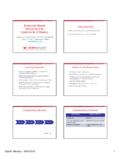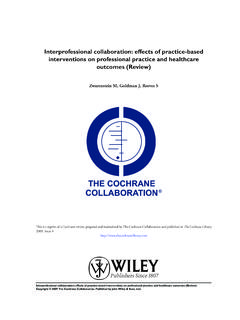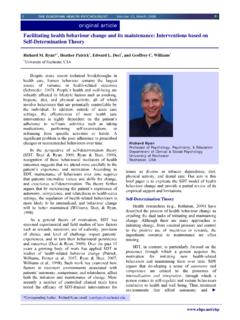Transcription of Productivity Assessment Tool: Computer-based cost benefit ...
1 Economic Evaluation Proceedings PaperTheProductivity Assessment tool : Computer-based cost benefitanalysis model for the economic Assessment of occupationalhealth and safety interventions in the workplaceMaurice Oxenburgha,1, Pepe Marlowa,b,*aOccupational Health and Ergonomics Consultant, 77 Ryan Street, Lilyfield, NSW, 2040, AustraliabPO Box 43, North Strathfield, NSN, 2137, AustraliaAbstractIntroduction and Method:This paper describes the concepts behind cost benefit analysis in occupational health and safety and introducesthe Productivity Assessment tool , a method by which an analysis may be performed relatively easily in a service or manufacturingworkplace.
2 The advantage of using such analyses is to show the important financial role that safe and efficient workplaces play in :By using analytical tools, the effectiveness of an intervention (workplace change) may be estimated prior to on Industry:This places occupational health and safety on the same financial footing as other proposed workplacechanges and thus places occupational health and safety in a strong position to attract scarce National Safety Council and Elsevier Ltd. All rights :Financial analysis; Cost benefit ; Productivity assesment; Economic assesment1. IntroductionIf a worker is adversely affected by his or her work, therewill be an adverse cost to the employer as well as to theindividual most visible form of adverse cost is time awayfrom work (recorded as a lost time injury).
3 However,productive time will also be lost where workers are not ableto work with total efficiency ( , due to poorly designedequipment or work procedures causing sore or tiredmuscles). Poor working conditions (lighting, dust, fumes,bullying, stress, etc.) may contribute to people staying awayfrom work or avoiding time in certain work areas. Poorquality job design and working conditions may also increasestaff managers know the direct wage costs of injuryabsence but are oftentimes not in a position to know theadditional or hidden costs. Several attempts have beenmade to calculate these hidden costs.
4 Andreoni showedthat the estimated hidden costs varied between and 20times the wage or salary costs (Andreoni, 1986); thisvariation was both between and within countries. In anunpublished survey we conducted in Australia, employersestimated that hidden costs were between nil and timesthe wages paid for unskilled or semi-skilled it is difficult to defend a choice of any one ratio forestimating hidden costs. Rather it is better to derive hiddencosts for each situation or, at least, each company ororganization. The items that constitute the greatest propor-tion of hidden costs include: overtime, over-employment (extra staffing), training, supervision, employee (labor) turnover, waste and rework lost production time, and reduced $ - see front matterD2005 National Safety Council and Elsevier Ltd.
5 All rights author. Tel.: + 61 2 9743 (P. Marlow).1 Tel.: + 46 8 662 of Safety Research - ECON proceedings 36 (2005) 209 are other cost items that may be significant inspecific situations and that should be taken into account: warranty costs, maintenance, product and plant damage, and equipment downtime (due to injury incidents).Lowered profit and reduced investment opportunities forthe organization are the end results of unnecessary costs dueto poor or unsafe working costs need to be included in an analysis toenable a comparison between occupational health andsafety funding requests and competing funding do this the costs due to occupational injury and disease,and consequent reduced Productivity , must be calculatedand the relative importance of the costs determined foreach workplace.
6 This is the rationale behind cost of the early work in the field of assessing the grosscosts of injury to the organization was devised by Dr. PaulaLiukkonen of Stockholms University; she was the first tocodify occupational health costs in a generic form. Most ofher work has been published in Swedish but she hassummarized some of her ideas in English (Kupi, Liukkonen,& Mattila, 1993).2. Methods for cost benefit Approaches to costingThere are several ways to cost an occupational healthand safety intervention that include, but are not limitedto, an insurance model and a cost benefit model scosting of work-relatedinjuries and injury absence uses the easily obtainedworkers compensation insurance information; this hasthe advantage of simplicity but it is also limited.
7 Itdoes not measure, for example, Productivity losses andemployee turnover and thus may seriously underestimatethe total costs of injury absence. As it may underesti-mate the total injury costs it will likewise underestimatethe potential savings from investment in avoidance ofthese costs. This insurance model will provide noincentive for small organizations with no history ofinjuries to implement occupational health and the other hand, acost benefit analysis modelmeasures all significant employment parameters that con-tribute to the product or service. It requires more data but,by assessing the total costs of employment and the lossesdue to injury or poorly designed workplaces, the model isspecific to that organization and is a better reflection ofemployment A specific cost benefit analysis toolTheProductivity Assessment Toolis a cost benefitanalysis model.
8 Its emphasis is on employees and thecosts and benefits that their employment brings to the first edition of the bookIncreasing Productivityand Profit through Health and Safety(Oxenburgh, 1991)there were 60 case studies illustrating occupational healthand safety solutions to poor working conditions and a paperversion of a cost benefit analysis model based on the workof Dr. Liukkonen. computer software for this model hasbeen developed and the latest version of the software,productAbility, is enclosed as a CD with the second editionof the above mentioned book (Oxenburgh, Marlow, &Oxenburgh, 2004).
9 The simplest and most frequent use of theProductivityAssessment Toolis to measure the increase in costeffectiveness of employees after an intervention. Morespecifically, it is time based and can compare a before and after model can also be used for analysis of, andcomparison between, two or more proposed interventions;it can assess the cost effectiveness for each interventionalthough it will not determine which is the mosteffective in injury prevention terms. The purpose of themodel is to examine cost effectiveness rather then interesting feature of the model is the use ofsensitivity analysis.
10 Organizations often do not realizewhich are the most sensitive cost parameters (especially ifthey are hidden ) and, by entering workplace data,modifications to this data will demonstrate the relativeimportance of each cost parameter (overtime, down-time,injury absence, employee turn-over, etc.).The software for this model can also be used to measurethe cost-effectiveness of rehabilitation for even a Assessment Toolhas been developed toconsider the costs and benefits of an intervention within arelatively short time period. It is assumed that the value ofthe money used to fund the intervention will remain exactlyconstant over the course of the project and it is usual to usethe input data and resultant data without currency mod-ification.















